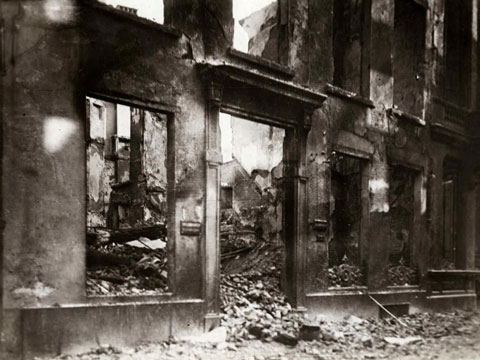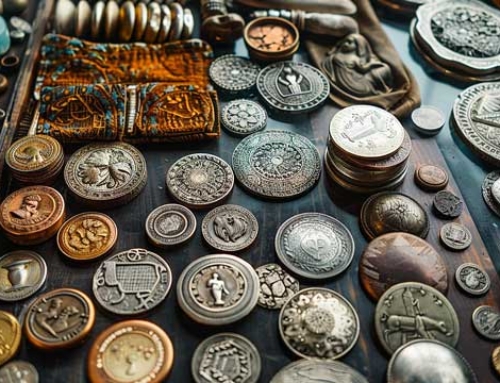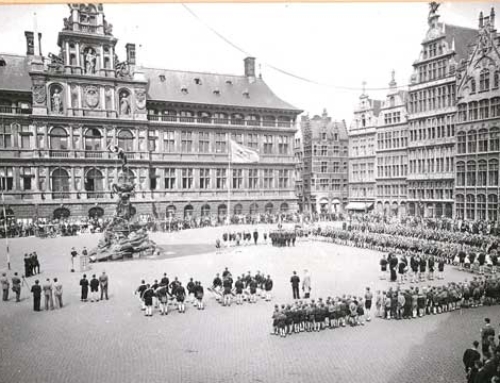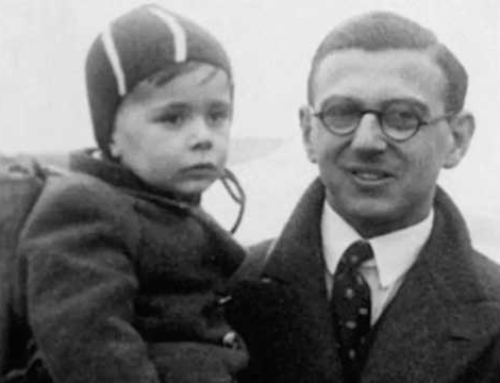Image: World War I: Completely burned and destroyed house in Antwerp after the bombardment. Antwerp, October, 1914 – source: Het Geheugen
Should you have missed parts 1 and/or 2, here where’s to read them first:
A commission was appointed to examine each case in the Netherlands individually. Only those who had no hostile feelings towards Belgium, and had not committed any hostile acts against an Allied country or against Belgium during the war, were allowed to return. Their “speedy” return was thus considerably delayed….
The campaign to get the workers back to Antwerp went smoothly. Workers in London and Birmingham were excited by the prospect of returning, even though they were earning up to four times more in England than in Belgium. Nor were the prospects very rosy; there was no work yet in Antwerp, and food prices were sky-high due to the war.
The meeting with the main merchants (J. Kryn, Max Tom, Salomon Himmelblau, G. Rombauts, Sam Tolkowsky, etc.) was more laborious. Homesickness played less of a role for them.
Now that prospects in England were better than in Antwerp, the merchants doubted whether they would return. At that time, large profits were still being made in England, while the diamond trade and processing in Antwerp was still at a standstill.
Moreover, the Belgian newspapers that reached England, as well as the British press itself, reported that they were no longer welcome in a strongly patriotic Belgium. In London they had been warmly welcomed in the diamond circles. The prospect of not being welcome in Antwerp was not at all conducive to a possible return.
Patriotic arguments did not help much, but the fact that the workers all wanted to return to Belgium presented them with a fait accompli. It was agreed that those who were employed at the time would continue to work until the end of February, no new personnel could be hired.
At the beginning of March the last workers were taken back to Belgium. About five of them continued to work as teachers in the school founded by Oppenheimer.
The repatriation of diamond workers from England to Belgium, proved insufficient to regain Antwerp’s supremacy in diamond processing and trade. The diamond trade was still in Amsterdam and even Oppenheimer did not give in so easily.
The lead that the Netherlands had been able to take over Antwerp through the war, Antwerp had not yet been able to catch up again.
A very important part of the foreign traders and workers were still in the Netherlands. The more time passed since the armistice, the less certain people in Belgium were whether the foreign traders would ever return.
In April 1919, four months had passed since Vandervelde had made it possible for them to return, yet hardly any merchants and manufacturers had returned from the Netherlands. On the contrary, they began to produce more and more in the Netherlands itself.
The Hague newspaper Het Vaderland wrote in late May with a triumphant tone that most of the large diamond traders had decided to stay in Scheveningen or to go to England. According to the newspaper, the smaller traders also seemed to be doing well in Scheveningen, their foreign currency trading doing quite well.
Raw material supplies had been brought from Antwerp to Amsterdam by London during the war. Antwerp now had to go to the Amsterdam Diamond Exchange to supply itself with rough. It was Amsterdam now that bought from London, and Antwerp from Amsterdam.
Because Antwerp traders were now buying second hand, they were paying up to 24% more than their Amsterdam counterparts. Because the diamond sector was doing so well throughout 1919, this was not felt so strongly in Antwerp.
After all, they could not employ more diamond workers in the Netherlands due to a lack of polishing mills. Moreover, the lower Belgian wages compensated for this difference, so that exports suffered little from this.
London had in the meantime started to investigate the possibility of establishing a Polish Syndicate in the Netherlands. If this succeeded, it was almost certain that these traders and the diamond trade would remain in Amsterdam.
If not, even then their departure was not certain. After all, they still had 20 million guilders worth of trade contracts with London running in the Netherlands.
The invective in the Belgian liberal press against the “Austro-boches” was by no means conducive to their return, especially since England and France were already busy negotiating with Austrian and German firms. Here they were less bothered by a patriotic conscience….
In early April 1919, the first batch of Congo diamonds, mined by the Compagnie Minière et Forestière, was sold under state supervision by the Société Générale.
The total, 43,000 carats, was put up for sale in a single lot, which left the smaller traders and homeworkers no chance to bid. About thirty Antwerp citizens had united to make a bid, but this proved too low; the entire lot was bought by the British (former German) Ernest Oppenheimer.
The conditions of sale stipulated that 60% of the lot had to remain in Belgium for processing, but the buyer obviously had first choice and could thus keep the best stones for himself.
The entire Antwerp diamond world found the actions of Minister of Colonies Franck in this matter far too lax. After all, he had promised to help the Antwerp merchants. Franck had been a vehement supporter of the repatriation of the foreign diamond merchants to save the Belgian diamond industry.
However, the vehement protests echoing from the liberal Belgian journals caused him to hesitate. Afraid that his patriotism would be questioned, he did not dare to draw the card of the diamond sector just like that.
This incident led to a change of opinion in the Belgian civil press. It was reluctantly admitted that the diamond sector needed the foreign traders and manufacturers. It was now clear that the Antwerp diamond sector was not strong enough.
Moreover, it was now recognized that military cooperation with England did not stand in the way of economic rivalry. In England patriotic objections did not stand in the way of a capitalist logic.
The newspaper of the Amsterdam diamond merchants, Diamant Handelsblad, wrote in capital letters at the end of May: “AFTER HAVING SPOILED EVERYTHING, THE BELGIAN PRESS NOW SHOUTS THAT THE GOVERNMENT MUST PROTECT THE DIAMOND INDUSTRY!”
The Brussels newspaper Het Vaderland asked why such a large quantity of diamonds had been put up for sale in one batch instead of in small batches, publicly and by auction, so that smaller traders would also have had a chance. In the Netherlands Franck’s actions were also questioned.
Het Handelsblad wrote that the Belgian government was not making enough effort for such an important industry. For the Netherlands this sale was also a bad thing, as there they were also not afraid of a strong English competitor.
A last important obstacle that stood in the way of the revival of the Antwerp diamond sector was the law on war chests.
In principle, all goods and interests of enemies on Belgian territory had to be placed under forced administration (sekwester). Only when you could prove that you no longer had an enemy nationality could you freely dispose of your own affairs again.
To be continued…. right here







